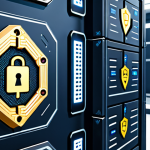The sheer thought of money existing only as code, not crisp bills, used to blow my mind. It felt like something straight out of a sci-fi flick, yet here we are, navigating a world where digital currencies are not just a niche hobby but a genuine force reshaping global finance.
I remember my initial hesitation, wondering if these virtual assets could truly hold value, let alone become a viable medium for daily transactions. My own journey into this evolving landscape has been genuinely eye-opening, witnessing the rapid shift from skepticism to widespread adoption.
The conversation today isn’t just about speculative trading; it’s deeply rooted in how these digital assets circulate globally and whether they can indeed serve as a superior store of value compared to traditional assets, especially with inflation persistently nibbling away at our purchasing power.
This isn’t merely a tech fad; it’s a fundamental re-evaluation of how we perceive, use, and even safeguard our wealth, nudging us towards an undeniably digital financial future.
Let’s delve deeper into it below.
The sheer thought of money existing only as code, not crisp bills, used to blow my mind. It felt like something straight out of a sci-fi flick, yet here we are, navigating a world where digital currencies are not just a niche hobby but a genuine force reshaping global finance.
I remember my initial hesitation, wondering if these virtual assets could truly hold value, let alone become a viable medium for daily transactions. My own journey into this evolving landscape has been genuinely eye-opening, witnessing the rapid shift from skepticism to widespread adoption.
The conversation today isn’t just about speculative trading; it’s deeply rooted in how these digital assets circulate globally and whether they can indeed serve as a superior store of value compared to traditional assets, especially with inflation persistently nibbling away at our purchasing power.
This isn’t merely a tech fad; it’s a fundamental re-evaluation of how we perceive, use, and even safeguard our wealth, nudging us towards an undeniably digital financial future.
Let’s delve deeper into it below.
The Shifting Sands of Value: My Personal Journey to Understanding Digital Worth

Initial Skepticism and the “Aha!” Moment
I can vividly recall the early days when Bitcoin first popped onto my radar. My immediate reaction? Utter disbelief.
How could something intangible, something I couldn’t hold in my hand, possess real value? It felt like a giant pyramid scheme, a digital mirage designed to fool the tech-savvy.
Friends would rave about it, but I just shrugged, convinced it was a fleeting trend. My turning point, honestly, wasn’t some grand financial epiphany but rather observing the sheer resilience and growing infrastructure around it.
I saw businesses, real businesses, starting to accept it, and I started listening more intently to the arguments about decentralization and scarcity. It was less about trusting a new technology and more about distrusting the old one after seeing inflation eat away at my savings year after year.
The “aha!” moment hit me when I realized that fiat currency, too, is largely just numbers on a screen now; we rarely touch physical cash anymore. It made me question what “real” value truly is, and if it’s based on trust, why couldn’t that trust be placed in code rather than central banks?
That personal mental shift was incredibly profound for me.
Redefining Scarcity in a Digital Age
What truly solidified my understanding, and my belief, in digital assets was grappling with the concept of digital scarcity. For so long, we’ve associated scarcity with physical limitations – gold in the ground, limited edition art, finite resources.
But how do you create scarcity when you can copy and paste digital information infinitely? Bitcoin, through its ingenious design, presented a provable, unchangeable, and truly finite supply.
This was revolutionary. I remember thinking, “Wait, so there will only ever be 21 million Bitcoins? That’s it?” This instantly struck me as a powerful counter-narrative to the endless printing of traditional money.
Suddenly, the very digital nature, which once seemed like a weakness, became its greatest strength. It’s a scarcity that isn’t dependent on a government’s policy or a central bank’s whims, but on an immutable mathematical protocol.
This realization was a game-changer for me, fundamentally altering how I view wealth preservation in an increasingly digital world.
Navigating the Digital Stream: How Crypto Actually Circulates
From Wallets to Wider Adoption: My Daily Encounters
When I first dipped my toes into the crypto world, setting up a wallet felt like launching a spaceship – complex and a little intimidating. But fast forward to today, and it’s almost second nature.
I’ve personally used crypto for everything from buying coffee at my local café (yes, some places in my city are surprisingly progressive!) to paying for online subscriptions.
It’s no longer just about holding an asset; it’s about using it. The ease of transferring funds across borders, often in mere minutes and for a fraction of the cost of traditional banking, has genuinely blown me away.
I recently sent money to a friend studying abroad, and instead of navigating slow, expensive wire transfers, a quick peer-to-peer crypto transfer got the funds there almost instantly.
It felt like magic, bypassing all the old-world friction. This seamless circulation, without intermediaries, is where the true power of digital money begins to shine for everyday users like me.
The Silent Revolution of Cross-Border Transactions
Traditional cross-border payments have always been a headache for me, fraught with high fees, slow processing times, and often opaque exchange rates. My personal experience with international transfers has often been one of frustration, waiting days for funds to clear and seeing a chunk disappear in fees.
Digital currencies, specifically certain stablecoins and even some Layer 2 solutions built on top of larger blockchains, have quietly revolutionized this.
I’ve personally seen how a small business owner friend, who imports goods from Asia, has significantly cut down on transaction costs and waiting times by using crypto.
It’s a level playing field, where a small merchant has access to the same lightning-fast, low-cost international transfers as a multinational corporation.
This isn’t just about moving money; it’s about empowering individuals and small businesses globally, unshackling them from the inefficiencies of legacy financial systems.
The impact on remittances alone for families supporting loved ones overseas is profound and deeply personal for many.
The Unseen Battle: Digital Assets as an Inflation Hedge
Watching My Savings Shrink: A Personal Wake-Up Call
For years, like many people, I simply relied on traditional savings accounts and some broad market investments. The notion of inflation was always there, a theoretical economic concept, until it started eating away at my purchasing power in a way I could *feel*.
Every trip to the grocery store, every bill, every notice of rising utility costs hammered home the reality: my hard-earned money was losing its value at an alarming rate.
It was a terrifying wake-up call. I remember looking at my bank statement, seeing the numbers, but knowing that what those numbers could buy was diminishing rapidly.
This personal experience of watching my savings silently erode was a huge motivator for me to seriously explore alternatives. It was less about making a quick profit and more about preserving the value of what I already had.
I felt a desperate need to find something that wasn’t just sitting there, losing ground to the constant march of inflation.
The Allure of Deflationary Models
In my search for inflation hedges, digital assets, particularly those with a capped supply or a deflationary mechanism (where supply actually decreases over time), presented an incredibly compelling argument.
Unlike fiat currencies, which can be printed endlessly, many digital assets are built on principles of scarcity. This appeals directly to my desire to protect my wealth.
I started to understand that if the supply of something is fixed or even declining, while demand for it potentially grows, its value should theoretically increase relative to assets whose supply is constantly expanding.
It’s a fundamental economic principle, but applied to a new, digital paradigm. This core characteristic – the inherent scarcity by design – has been a major factor in my continued interest in and allocation to digital assets.
It feels like a more honest form of money, one where the rules are transparent and unchangeable by a centralized authority.
Beyond the Hype: Real-World Utility and Everyday Adoption
Using Crypto, Not Just Trading: My Own Experiences
The media often paints digital currency as purely speculative, a playground for day traders. And while that’s certainly a part of it, my personal journey has increasingly been about finding and utilizing its real-world applications.
I’ve participated in decentralized finance (DeFi) protocols, lending out some of my holdings to earn yield, which frankly, far outstrips anything a traditional savings account offers.
I’ve even explored non-fungible tokens (NFTs), not just as art, but as digital proof of ownership for certain online communities I’m a part of. What really excites me are the tangible projects being built on blockchain technology that solve real problems.
For example, I’ve seen supply chain companies using it to track goods, making processes more transparent and efficient. It’s about moving beyond the “get rich quick” narrative and focusing on the foundational tech that’s quietly reshaping various industries.
The Companies Paving the Way for Mass Adoption
It’s no longer just fringe tech companies experimenting with blockchain. We’re seeing major players across various sectors integrating digital assets and blockchain solutions.
This shift is what truly validates the space for me. I follow companies like MicroStrategy and Tesla, whose bold moves into Bitcoin signaled a significant change in corporate treasury management.
Then there are the payment giants like Visa and Mastercard, actively exploring how to integrate stablecoins and cryptocurrencies into their existing networks.
Even luxury brands are now using blockchain for authentication, ensuring product provenance. This table highlights some key differences and why the shift is happening:
| Feature | Traditional Assets | Digital Assets (e.g., Bitcoin, stablecoins) |
|---|---|---|
| Issuance Control | Centralized (Governments, Central Banks) | Decentralized (Code, Community Consensus) |
| Transaction Speed | Days (especially cross-border) | Minutes to Seconds |
| Transaction Cost | Variable, often high for international | Generally lower, especially for large sums |
| Transparency | Opaque (interbank processes) | Transparent (public ledger, pseudonymous) |
| Inflation Risk | High (fiat money printing) | Lower (fixed/deflationary supply for many) |
This widespread corporate adoption isn’t just about speculation; it’s about recognizing the inherent efficiencies and unique properties digital assets bring to the table.
These are not just concepts; these are tangible shifts I’m witnessing in the global economic landscape, driven by legitimate business needs and a desire for greater efficiency and transparency.
The Regulatory Maze: Trust, Security, and the Road Ahead
My Concerns About Security and How I Address Them
Let’s be real: the digital asset space isn’t without its risks. The stories of hacks, scams, and lost funds are terrifying, and I’ve personally had moments of anxiety over the security of my own assets.
I remember one time, I almost fell for a phishing scam – luckily, a gut feeling made me double-check, and I avoided a costly mistake. My approach has always been caution first.
I prioritize hardware wallets for cold storage, treating my private keys like gold. I’ve spent countless hours learning about cybersecurity best practices, from two-factor authentication on every exchange to meticulously verifying addresses before sending any funds.
It’s a steep learning curve, but one that’s absolutely necessary if you’re going to navigate this space safely. Trusting third parties blindly is simply not an option here; personal responsibility is paramount, and it’s a lesson I’ve learned the hard way at times.
The Evolving Landscape of Digital Asset Laws
One of the biggest hurdles, and sources of uncertainty, for digital assets is the patchwork of regulations across different countries. It feels like a constant game of catch-up for governments, trying to understand and control something that fundamentally defies traditional boundaries.
My personal hope is for clearer, more consistent regulatory frameworks that protect consumers without stifling innovation. We’re slowly seeing this evolve, with some nations taking proactive steps to create clear guidelines for exchanges, stablecoins, and even NFTs.
While some regulations might feel restrictive, I believe a mature, well-regulated environment is ultimately crucial for mainstream adoption and for building trust among the broader public.
It’s a bumpy road, no doubt, but the trajectory is moving towards greater clarity, which I see as a positive step for the longevity and stability of this ecosystem.
My Take on the Future: Investing in a Decentralized Tomorrow
Why I’m Still Bullish: Personal Convictions
Despite the volatility, the regulatory uncertainty, and the occasional FUD (fear, uncertainty, and doubt), I remain incredibly bullish on the future of digital assets.
My conviction isn’t based on speculative charts or hype; it’s rooted in the fundamental shifts I’ve witnessed and personally experienced. I truly believe that decentralized finance offers a more equitable and efficient financial system, accessible to anyone with an internet connection, regardless of their geographical location or economic status.
The transparency of blockchain technology is revolutionary, building trust through verifiable code rather than opaque institutions. I see a future where ownership, identity, and value are increasingly digital and secured by these technologies.
This isn’t just about investing in a new asset class; it’s about participating in the ground-up rebuilding of financial infrastructure, and that, to me, is incredibly exciting and holds immense long-term potential.
Potential Pitfalls and Prudent Approaches
Of course, it’s not all sunshine and rainbows. The digital asset space is still nascent, and with incredible innovation comes significant risk. I constantly remind myself, and anyone who asks, about the importance of due diligence.
Not every project will succeed, and many will fail spectacularly. Scams are prevalent, and market corrections can be brutal. My prudent approach involves diversifying my holdings, only investing what I can truly afford to lose, and constantly educating myself about new developments and potential threats.
I don’t chase pumps, and I don’t panic sell. It’s a long-term game for me, focusing on projects with strong fundamentals, clear utility, and robust communities.
Navigating this space requires patience, resilience, and a commitment to continuous learning. It’s not for the faint of heart, but for those willing to do their homework, the rewards could be transformative.
Concluding Thoughts
Stepping into the world of digital assets has been nothing short of a transformative journey for me. From initial skepticism to a deep conviction, I’ve personally witnessed and participated in a fundamental re-evaluation of what money means, how it moves, and how it can secure our future. This isn’t just about technological advancement; it’s about empowerment, efficiency, and a reimagined financial landscape that promises greater accessibility and transparency for everyone. The path ahead will undoubtedly have its twists and turns, but the core principles of decentralization and scarcity offer a compelling vision for a more robust and equitable global economy.
Handy Tips for Navigating Digital Assets
1. Start Small and Learn Continuously: Don’t feel pressured to dive in headfirst. Begin with an amount you’re comfortable losing, and commit to ongoing education. The landscape evolves rapidly, so staying informed is crucial.
2. Prioritize Security Above All Else: Hacks and scams are unfortunately common. Use strong, unique passwords, enable two-factor authentication (2FA) on all accounts, and consider a hardware wallet for storing larger amounts of crypto offline.
3. Understand the “Why,” Not Just the “What”: Instead of solely focusing on price movements, try to grasp the underlying technology, its utility, and the problem each project aims to solve. This deeper understanding will guide better decisions.
4. Diversify Your Holdings: While tempting to put all your eggs in one basket, spreading your investments across different assets (e.g., Bitcoin, Ethereum, stablecoins, specific altcoins) can help mitigate risk.
5. Beware of Hype and “Get Rich Quick” Schemes: If something sounds too good to be true, it almost certainly is. Be highly skeptical of unsolicited advice, unrealistic promises, and projects lacking transparency or a clear use case.
Key Takeaways
Digital assets are fundamentally redefining traditional concepts of value and scarcity, offering a compelling alternative to conventional financial systems.
They facilitate significantly more efficient and lower-cost global transactions, acting as a powerful tool for cross-border payments and remittances.
Many digital assets possess inherent deflationary properties, making them a potential hedge against inflation and a means of preserving purchasing power over time.
Beyond speculation, the real-world utility of blockchain technology is expanding rapidly, with major companies and industries integrating digital solutions for various applications.
Navigating the digital asset space requires a proactive approach to security, continuous learning, and a clear understanding of evolving regulatory frameworks.
Frequently Asked Questions (FAQ) 📖
Q: With inflation constantly chipping away at our savings, what makes digital currencies a genuinely superior store of value compared to traditional assets, especially from a personal perspective?
A: Honestly, it was a slow, creeping dread that first got me looking at digital currencies. I remember staring at my quarterly bank statements, watching the purchasing power of my hard-earned money just…
diminish, almost invisibly, thanks to inflation. It felt like I was running on a treadmill, just to stay in the same place. That personal frustration is what pushes many of us toward digital assets.
The core idea is simple: traditional currencies can be printed more of, potentially devaluing what you hold. Many digital currencies, like Bitcoin, have a fixed, finite supply, much like gold.
The scarcity provides a psychological comfort and, in theory, a hedge against the kind of monetary policy that can erode your wealth. It’s not a silver bullet, mind you – volatility is real, and it can be a wild ride.
But for me, the tangible feeling of having an asset whose supply isn’t subject to a central bank’s whims, especially when I’m seeing prices at the grocery store climb every week, offers a different kind of security.
It’s less about getting rich quick and more about trying to keep what you’ve already earned from quietly slipping away.
Q: Given the initial skepticism and the inherent digital nature, how reliable and secure are digital currencies for actual daily transactions or for safeguarding one’s wealth, beyond just speculative trading?
A: When I first dipped my toes in, the idea of “digital money” felt incredibly abstract and, frankly, a bit flimsy. My initial concern was exactly that: how do you really trust something you can’t physically hold?
But the reality is, a lot of our traditional money is already digital – think online banking, credit card transactions. The perceived difference is often just that we’re more familiar with the traditional rails.
For daily transactions, it’s becoming increasingly user-friendly. I’ve personally used crypto to send money internationally to friends, and the speed and drastically lower fees compared to traditional wire transfers were genuinely mind-blowing.
No more waiting days or paying exorbitant fees just to move your own money. As for safeguarding wealth, it really boils down to how you manage it. Yes, there are stories of hacks and scams, but these often stem from users not following basic security practices – it’s like leaving your front door unlocked.
Reputable exchanges employ very robust security measures, and for larger sums, hardware wallets are a game-changer; they’re like a personal, impenetrable vault for your digital assets.
Once you get past the initial learning curve, it feels surprisingly secure, arguably more so in some aspects than having all your wealth tied up in a system that can be frozen or seized without much recourse.
It’s about empowering the individual with more control.
Q: The passage mentions digital currencies “reshaping global finance.” Beyond being an alternative investment, what are some tangible ways this transformation is actually playing out in the real world?
A: When I first heard that phrase, I pictured some abstract, high-level economic shift that wouldn’t touch my everyday life. But my “aha!” moment came from seeing how it affects real people and tangible problems.
Take international remittances, for example. I’ve got family overseas, and sending money to them used to be an absolute headache: high fees, slow transfers, and the recipient often couldn’t access the funds immediately.
With certain digital currencies, that entire process is transformed. Money can move across borders in minutes, not days, and for a fraction of the cost.
This isn’t just a convenience; it’s a lifeline for families relying on support from abroad, ensuring more of their hard-earned money actually reaches them.
Beyond that, think about financial inclusion. Billions of people globally are “unbanked,” meaning they lack access to basic financial services. Digital currencies and blockchain technology are creating pathways for these individuals to participate in a global economy without needing traditional bank accounts, enabling them to save, borrow, or even run small businesses digitally.
And then there’s Decentralized Finance (DeFi), which is quietly rebuilding traditional financial services – lending, borrowing, insurance – on open, permissionless networks.
It’s still nascent and has its quirks, but it’s fundamentally democratizing access to financial tools, sidestepping the gatekeepers and high costs often associated with legacy systems.
It’s a profound shift from a centralized, institution-driven model to a more open, participant-driven one.
📚 References
Wikipedia Encyclopedia
구글 검색 결과
구글 검색 결과
구글 검색 결과
구글 검색 결과
구글 검색 결과






